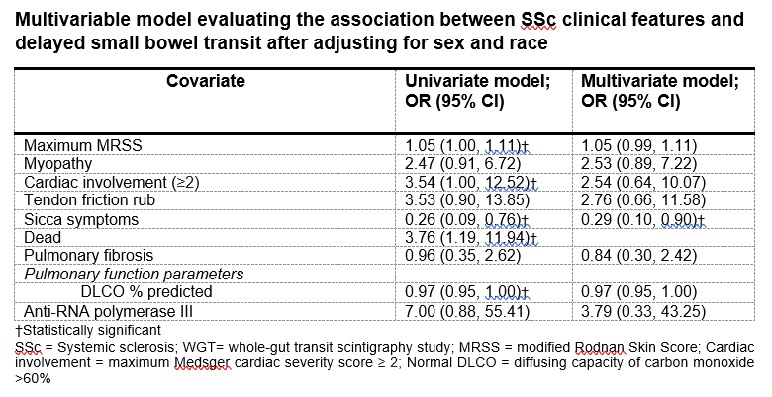Session Information
Date: Sunday, November 12, 2023
Title: (0609–0672) Systemic Sclerosis & Related Disorders – Clinical Poster I: Research
Session Type: Poster Session A
Session Time: 9:00AM-11:00AM
Background/Purpose: The gastrointestinal (GI) tract is the second most commonly affected organ in patients with systemic sclerosis (SSc). It is estimated that the small bowel is involved in up to 50% of SSc patients at tertiary referral centers. Although some patients have mild disease, some have severe complications and may require total parenteral nutrition (TPN) to sustain life. Our aim was to identify demographic and clinical features associated with SSc patients who have delayed small bowel transit to better characterize patients at risk for this complication.
Methods: SSc patients with GI symptoms were prospectively enrolled in our study and underwent a scintigraphy-based whole gut transit (WGT) study. A cross-sectional analysis was then performed comparing demographic and clinical features between patients with and without objective small bowel transit delay by WGT. We also compared UCLA GIT 2.0 symptoms between these patient groups. Univariate logistic regression models were used to examine clinical features associated with delayed small bowel transit and a multivariable model was created using significant variables from our cross-sectional analysis and known confounders to further evaluate these associations.
Results: Of 131 patients enrolled in this study, 24 (18%) had delayed small bowel transit (defined at < 49% emptying at 6 hours). Patients with delayed small bowel transit were less likely to be female [79%, (19/118) vs. 93% (99/118); p=0.05], to be white [67%, (16/105) vs. 84% (89/105); p=0.05], and to have sicca symptoms [68% (15/107) vs. 89% (92/107); p=0.01]. Those with delayed small bowel transit were more likely to have low (worse) mean DLCO (51% vs. 68%, p=0.03) and were more likely to die [26% (6/15) vs. 9% (9/15); p=0.02]. In the univariate analyses, we determined that a higher modified Rodnan skin score [Odd’s ratio (OR)=1.05, confidence interval (CI) 1.00-1.11, p=0.05], more cardiac involvement (OR=3.54, CI 1.00-12.52, p=0.05), less sicca symptoms (OR=0.26, CI 0.09-0.76, p=0.02), and lower DLCO (OR=0.97, CI 0.95-1.00, p=0.03) were associated with delayed small bowel transit. In the multivariable model, sicca symptoms (OR=0.29, CI 0.10-0.90, p=0.03) remained negatively associated with delayed small bowel transit.
Conclusion: These findings suggest delayed small bowel transit in SSc is associated with a high mortality and a specific clinical phenotype. Recognizing patients at risk for delayed small bowel transit is important for clinical care and in the design of future studies evaluating this high-risk group.
To cite this abstract in AMA style:
Cheah J, Perin J, Hughes M, Paik J, Mecoli C, Hummers L, Shah A, Wigley F, McMahan Z. Demographics and Clinical Features Associated with Small Bowel Hypomotility in Systemic Sclerosis [abstract]. Arthritis Rheumatol. 2023; 75 (suppl 9). https://acrabstracts.org/abstract/demographics-and-clinical-features-associated-with-small-bowel-hypomotility-in-systemic-sclerosis/. Accessed .« Back to ACR Convergence 2023
ACR Meeting Abstracts - https://acrabstracts.org/abstract/demographics-and-clinical-features-associated-with-small-bowel-hypomotility-in-systemic-sclerosis/

